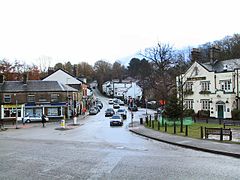Disley
| Disley | |
|---|---|
 Disley village centre |
|
| Disley shown within Cheshire | |
| Population | 4,294 (2011) |
| OS grid reference | SJ972845 |
| • London | 186 miles (299 km) |
| Civil parish |
|
| Unitary authority | |
| Ceremonial county | |
| Region | |
| Country | England |
| Sovereign state | United Kingdom |
| Post town | STOCKPORT |
| Postcode district | SK12 |
| Dialling code | 01663 |
| Police | Cheshire |
| Fire | Cheshire |
| Ambulance | North West |
| EU Parliament | North West England |
| UK Parliament | |
Disley is a village and civil parish in the unitary authority of Cheshire East and the ceremonial county of Cheshire, England. It is located on the very edge of the Peak District, in the Goyt Valley, very close to the county boundary with Derbyshire at New Mills, and south of , Greater Manchester. The population of the civil parish as taken at the 2011 Census was 4,294. To the north of the village, the River Goyt and the Peak Forest Canal, which opened in 1800, passes along the edge of the village. Today it is a dormitory village retaining a semi-rural character.
Disley railway station is on the Manchester to Buxton line, with through trains to Preston and Blackpool.
The parish includes part of the neighbouring village of Newtown, the bulk of which is in Derbyshire.
Its Anglo-Saxon name was Dystiglegh meaning wood or clearing by a mound or possibly "windy settlement". In the 13th century, in the time of Edward I, there are references to confirmatory grants of land made to Jordan de Dystelegh of Disley Hall and Roger de Stanley-de-Dystelegh of Stanley Hall in the district, pointing to even older local settlements. It later had the name Dystelegh.
Sir Piers Legh of Lyme founded St Mary-the-Virgin Church in Disley (completed 1524) and consecrated as parish church in 1558. The earliest parish register is from 1591.
The village had at least one cotton mill by the mid-19th century. As the cotton industry declined, more varied employment became the norm. In 2005, there is a paper mill and some light engineering works, but most people travel out to work.
...
Wikipedia

